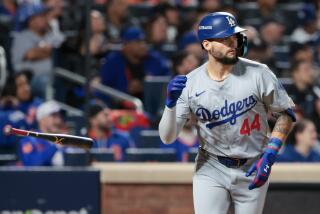Honeycutt Still Looking for That First Out : In Two Games, A’s Reliever Has Faced Six Blue Jays and Retired None
- Share via
TORONTO — Rick Honeycutt remembers it as “the low point” of a 13-year major league career.
He was 2-12 as a starter-reliever with the Dodgers in 1987, was traded to the Oakland Athletics for Tim Belcher in late August and finished that season with an overall record of 3-16.
“This is a game that can humble you very quickly, but to come back from that the way I did builds a lot of character,” Honeycutt said Friday night.
He was standing at his locker in the A’s clubhouse, knowing he is now faced with another test of the confidence and character he rebuilt via two successful seasons in the Oakland bullpen--as set-up man for Dennis Eckersley and, at times, as the closer himself.
If Honeycutt fails the test, the A’s may fail, too, in the opinion of Manager Tony LaRussa, who watched the Toronto Blue Jays cut his team’s American League playoff lead to 2-1 with a 7-3 victory, during which Honeycutt pitched poorly for the second straight game.
“I don’t think we can win without him (pitching well),” LaRussa said of the 35-year-old left-hander. “He has one of the most important roles on the club.
” He’s not only the set-up man against left-handers, but he’s also the closer when Eck isn’t available.”
Told about LaRussa’s doubt regarding the A’s ability to win without him, Honeycutt said, “I wouldn’t go that far. We showed this year that we can play with a lot of people out.
“But with the role I’m in, if I fail again, it definitely becomes tougher.”
Honeycutt entered Game 2 Wednesday in Oakland with the A’s holding a 6-1 eighth-inning lead. What looked like an easy mop-up turned into a mess.
He faced three batters. The first singled, the next two walked. LaRussa was forced to go to Eckersley with the bases loaded. Two runs scored, but the A’s won, 6-3.
Friday night, with runners at first and second, one out in the seventh and the A’s trailing by only 4-3, Honeycutt came on and faced three more batters.
The first, Manny Lee, singled to make it 5-3. The second, Junior Felix, singled to load the bases. The third, Lloyd Moseby, walked to force in the sixth run and leave the bases loaded.
“Nobody said it would be easy,” LaRussa told Honeycutt as he took the ball and called in Gene Nelson.
Easy? Honeycutt has faced six batters in this series. Three singled and three walked.
“I thought he threw better tonight but you can’t tell it by the stats,” LaRussa said later. “It’s like anybody else who gets in a period of funkiness, you stay with him.
“If the situation develops tomorrow, he’ll be back in there.”
Said Honeycutt: “As bad as I’ve been the last two games, I think I’ve done the job long enough and well enough for Tony that he still believes in me. I have some confidence to re-create, but I know I’m not as bad as I’ve been in these last two games.
“And I’m not going to let a couple games ruin what the last two years have meant to me.”
Coming from that low point with the Dodgers, Honeycutt appeared in 55 games in 1988. He saved seven and had a 3-2 record.
This year, he was even better. He appeared in a club-high 64 games, recording a career-best 12 saves with a career-low 2.35 earned-run average.
And when Eckersley went out with a shoulder injury May 27 and missed 40 games, Honeycutt registered 10 saves in 10 chances.
“I had something to prove, to myself and people in baseball,” Honeycutt said, reflecting on the rejuvenation of his career. “I didn’t come to Oakland with this role because I had never relieved regularly before. But as the season progressed, with each success, I grew into it.
“It was a learning experience, and to come back the way I did, to be able to pitch well for a winning club at this point in my career, has been a very satisfying and rewarding experience.”
Amid what he called the soul-searching of that fourth and final year in Los Angeles, Honeycutt received help from Dr. Saul Miller, a sports psychologist.
“I needed something,” Honeycutt said, patiently answering questions in the A’s clubhouse. “I was taking the game home with me. I was confused and frustrated.
“I’m not saying that it was a miracle cure because talk is cheap and I still had to perform, but at the time it gave me inner peace and something to reach from.
“We’ve stayed in touch and I still use a lot of the things I learned, but I don’t think my current situation is something you call the doctor about and get a prescription.
“There’s no miracle cure. It’s something I have to find inside myself. I have to use my experience and reach back in my memory bank and pull out some good videos to get back to the way I was.”
Honeycutt said he feels fine physically but has entered the last two games devoid of the slider that is imperative to his success against left-handed batters.
“When you’re out there for a short time and don’t have your best pitch,” he said, “it’s frustrating, and bad things are going to happen.
“I’m searching right now, and the best thing that could happen would be for me to go right back out there and get an out. One out. That’s all I need right now.”
Honeycutt has now pitched in nine playoff games with the Dodgers and A’s, allowing 11 hits, seven walks and nine earned runs in five innings. His playoff ERA is 16.20.
He is as mystified by that as he is by the misfortune of the last two games, but he carries the success of the last two years, the knowledge that he has rebuilt his character and confidence once before. One out doesn’t seem so tough when you’ve been as low as Rick Honeycutt was in ’87.
More to Read
Are you a true-blue fan?
Get our Dodgers Dugout newsletter for insights, news and much more.
You may occasionally receive promotional content from the Los Angeles Times.








